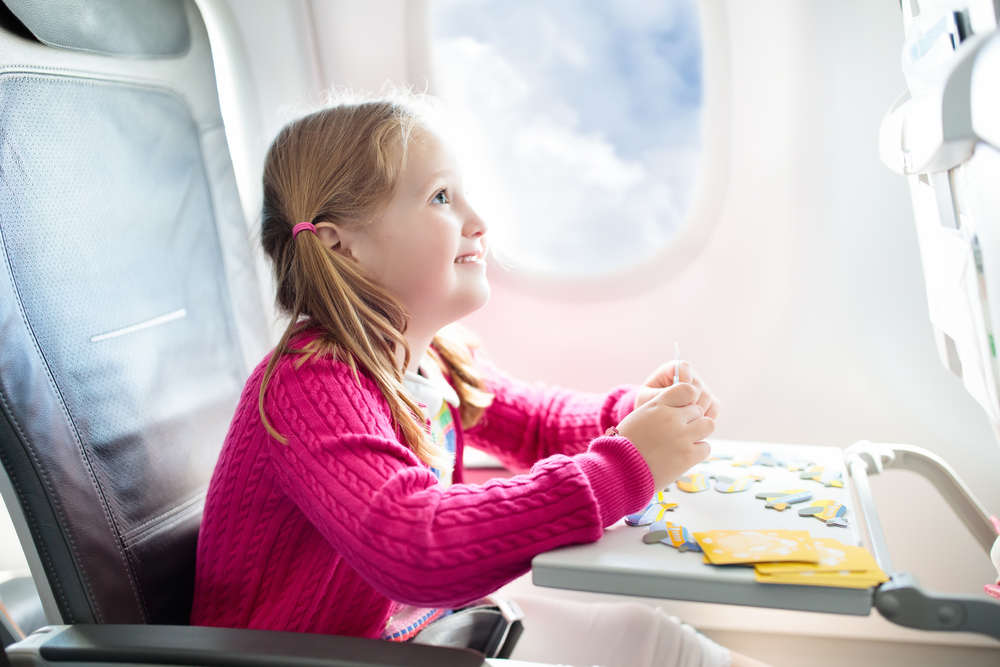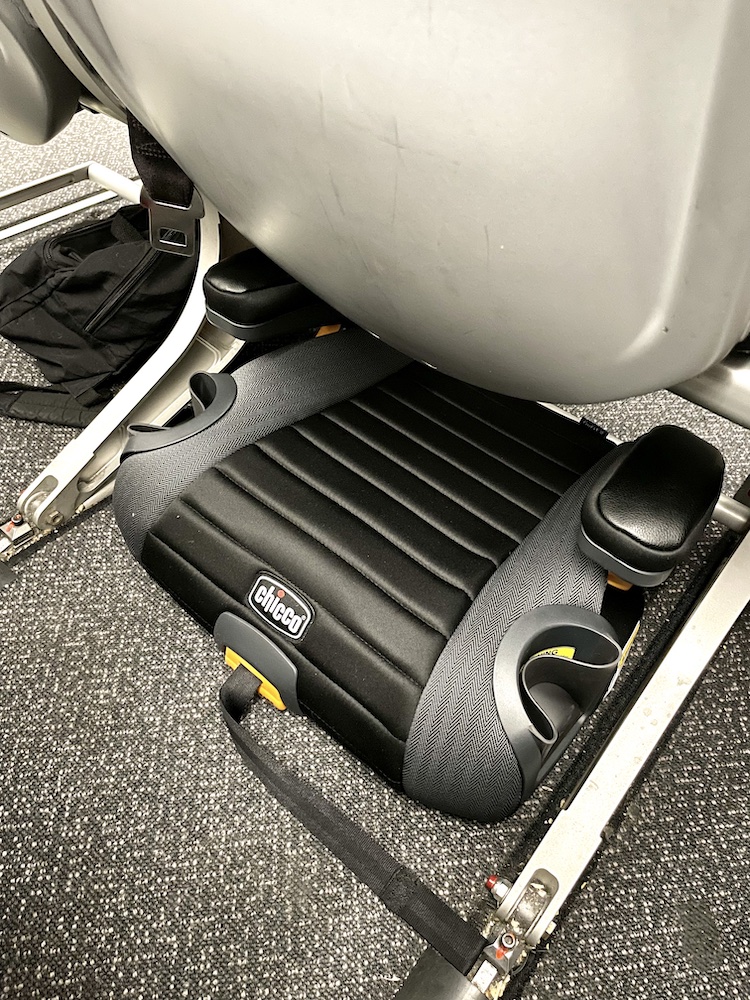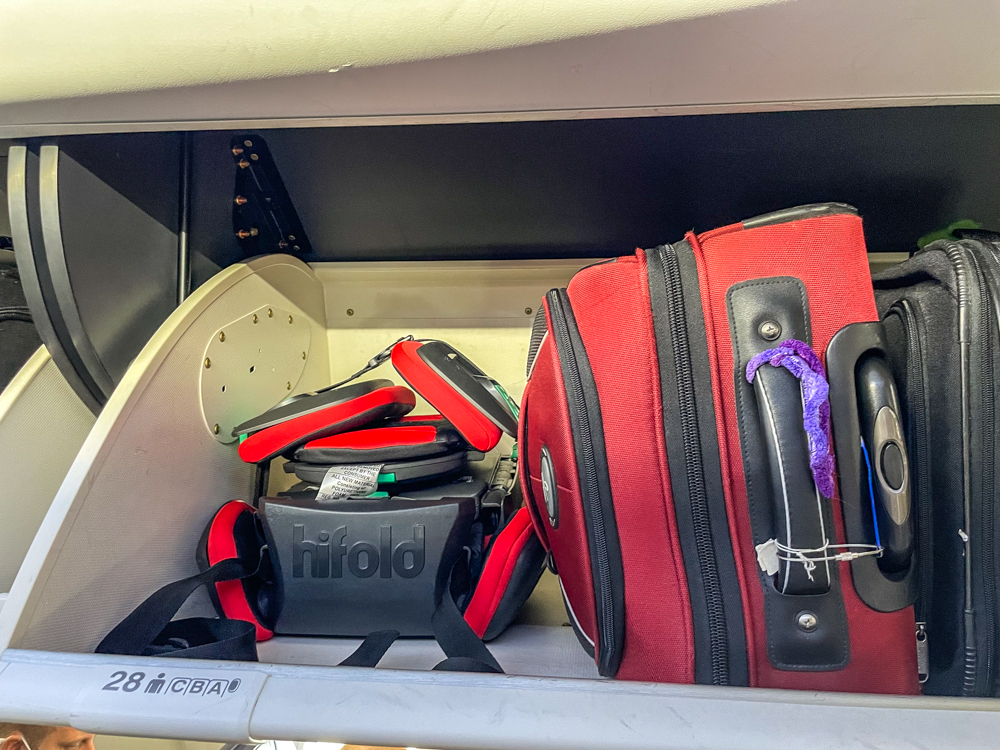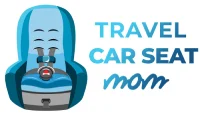This article about taking a booster seat on an airplane is written by certified Child Passenger Safety Technician Melissa Conn and may contain affiliate links.
While there’s plenty to know about flying with a car seat, flying with a booster seat is much more straightforward. As long as your child is big enough and mature enough to ride in a booster seat (often not until age 5 or 6), making the switch can make your travels a heck of a lot easier.
Many parents wonder “can you bring a booster seat on a plane?” There are a few details to know in advance for a successful trip! Be sure to read these quick tips for bringing a booster seat on an airplane before you go:
Flying with a booster seat is easy
Booster seats are generally lighter than harnessed car seats. In fact, there are tons of awesome travel booster car seats to choose from that or ultra-light or even fold up for easy carrying and storage! Some booster seats weigh as little as 1 pound, while others can fit in your child’s carry-on backpack.
If your child is at least 40 pounds but you think he might not be mature enough to ride in a traditional booster seat in the car, take a look at the Ride Safer Travel Vest. It folds up small and doesn’t weigh much, so it’s easy to take in a carry-on but will keep your kid safe.
Can you use a booster seat on an airplane?

A booster seat’s job is to position a lap-shoulder seatbelt correctly on a child’s body. Since airplane seatbelts only have a lap portion, you can not use a booster seat on an airplane.
Even with some of the new premium seats that have lap-shoulder belts, you likely won’t be allowed to install a booster seat.
If you’re thinking about using a combination car seat (sometimes called a harnessed booster seat) on a plane, you’ll probably see a sticker with the following language – which can confuse both parents and flight crews:
When used with the harness system: This restraint is certified for use in Motor Vehicles and Aircraft. When used without the harness system as a belt positioning seat: This restraint is not certified for use in Aircraft.
That just means that if you’re using a travel car seat like this one, it’s fine to use it on a plane in harness mode but not in booster mode. That’s an example of “FAA approved booster seats” but only because it has a harness option. If your booster seat doesn’t have a harness mode, it’s not FAA approved. There’s no such thing as an airplane booster seat.
The vast majority of booster riders don’t need a car or booster seat on a plane since they’re over 40 lbs, the weight at which the FAA says airplane seatbelts fit kids well enough. But if it’s a choice between checking your harnessed booster seat or using it on board, I’ll choose using it on board with the harness every single time – find out why.
Can a booster seat be a carry on?

Yes, a booster seat can be a carry on! We’ve taken booster seats on airplanes many times… but it depends on the size. If you’re bringing a backless booster, it’s easy to stick under the seat in front of your child or in the overhead bin. For a traditional booster seat, we bring this one thanks to its integrated carry handle and road trip friendly cup holders. If we won’t be doing too much driving, we love this inflatable booster seat that packs down into our son’s backpack. Read my in-depth Bubblebum review here.

If your child isn’t ready for a backless booster seat, your best bet for taking a booster seat as a carry on is to pick up a folding booster seat. Sadly my favorite folding booster seat (pictured below) has been discontinued. The next best option is the Peg Perego Viaggio Flex 120, which should fit in most overhead bins but perhaps not on the smallest regional hopper planes.

There are plenty of other travel highback booster car seats to choose from, but many of them fold too big to take as a carry on. If need be, you can remove the back of a normal booster seat and check it in a hard-sided suitcase and bring the backless portion as a carry on. Even if your luggage gets lost, you’ll still be able to use the backless portion on its own in a pinch.
Do you need a booster seat bag?

There are a few travel booster seats that come with a “booster seat bag” or give the option to purchase one separately. Do you need one? It’s really a matter of personal preference.
If you’re bringing a full-size backless booster seat with you, it may be easier to take it through the airport in a booster seat bag. That’ll give you the option of carrying it with the shoulder strap or putting it over the handle of wheeled luggage. We don’t own one yet, but I might buy one before our next trip! We should be able to fit both our new Graco Turbo GO (full review here) and our Ride Safer Travel vest (full review here) inside.
Make sure a booster seat is the right choice for your trip
Before you commit to traveling with a booster seat, make sure it’s the right choice for your child and your trip. What exactly does that mean?
- Your child should meet the minimum size and age requirements of their booster seat – each seat has its own standards.
- Your child should be mature enough to sit correctly in the booster seat 100% of the times, even if they’re tired after a long flight across many time zones.
- Be sure that your child meets the booster seat requirements of whatever country you’re visiting. Some of them are much more stringent than in the US. Find more information on booster seat rules for Australia, Costa Rica and Europe.
Booster seat on airplane FAQs
You can take a booster seat on a plane to transport it, but you can’t use a booster on a plane unless it has the option to be used in a harness mode.
You can take a high back booster on a plane to transport it, but you can’t use a high back booster on a plane unless it has the option to be used in a harness mode.
If you are bringing a backless booster seat, the best option is to take it in (or as) your carry-on luggage. If you are traveling with a highback booster seat, the safest choice is to separate the seat and the back; put the back in the overhead bin or pack it in your luggage and bring the seat on board as a carry-on. Alternatively, you can bring a booster seat that folds small enough to fit in the overhead bin.
If you choose to check your booster seat, most airlines don’t count it against your checked luggage allowance. Passengers are generally allowed one (sometimes two) free “baby items” per child.
Usually you can check a booster seat for free, but it’s recommended to bring at least the bottom of the seat on board with you.
In my experience flying a wide range of airlines, flight crews do not count backless booster seats (or folded travel highback booster seats) as a carry-on or personal item. My kids have put them under the seat in front of them with a small back pack on top or next to it, and sometimes we’ve put it in the overhead bin.

I’m wondering about the width of harnessed boosters in order to use on a plane. I can’t find any that are within the “16.5″ / 17.3″ “ width of Alaska Airlines seats. Can you install a seat with the arm rests up? Can it be wider than the seat? I’m so lost.
Hi Ashlee,
Thanks for stopping by! Yes, you generally CAN put the arm rest up to install. It only becomes an issue if you’re putting two kids side by side in very wide car seats. If you share your kid’s age/height/weight I’m happy to help you choose one that’ll work well 🙂
Safe travels,
Melissa